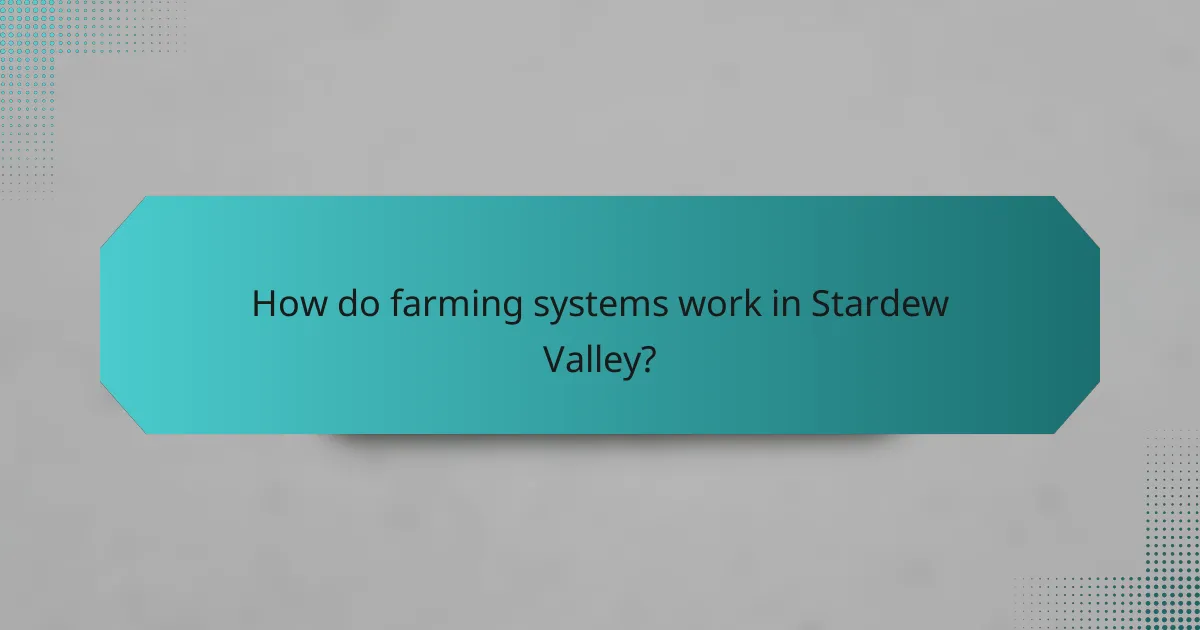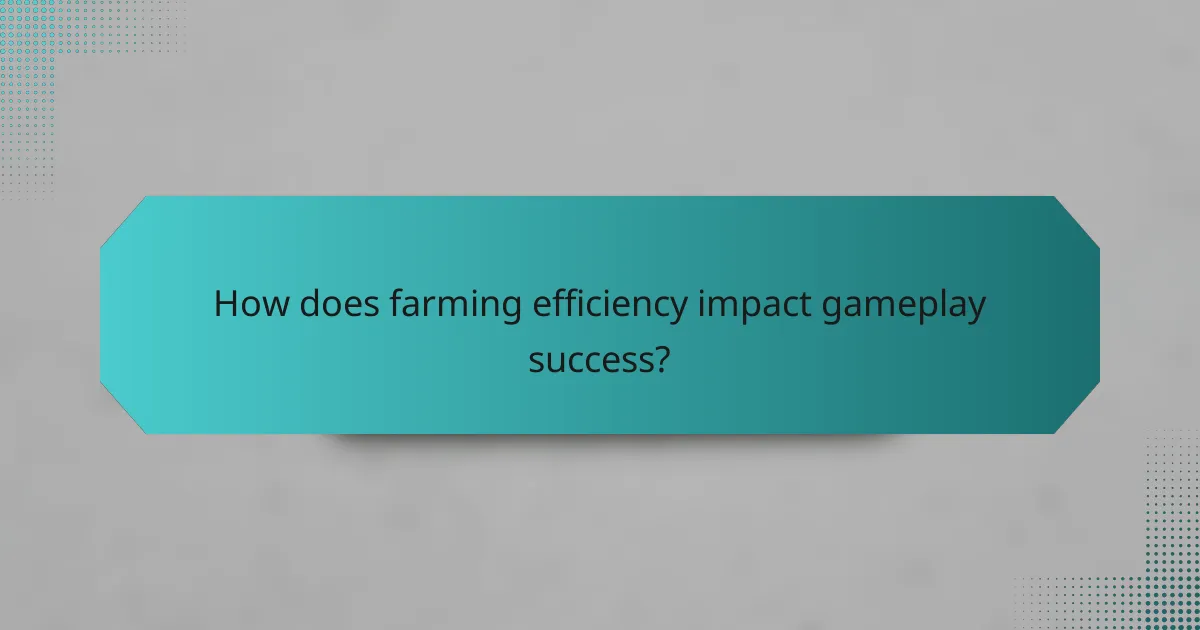Stardew Valley offers a rich farming experience through diverse crop cultivation, animal husbandry, and resource management. Players can enhance their productivity with effective crafting systems while engaging with the community through festivals and friendship-building activities. Efficient farming techniques lead to improved yields and deeper interactions, ultimately enriching gameplay.

How do farming systems work in Stardew Valley?
Farming systems in Stardew Valley operate through crop cultivation, animal husbandry, and resource management. Players can plant a variety of crops, each with specific growth times and seasonal availability. Animal husbandry involves raising livestock for products like milk and eggs, contributing to farm productivity. Crafting systems enable players to create tools, machines, and artisan goods, enhancing efficiency and profitability. Community engagement through festivals and quests further enriches the farming experience, fostering relationships and unlocking new features.
What are the different crop types available?
Stardew Valley features various crop types, including vegetables, fruits, and flowers. Each crop has distinct growth cycles and uses.
| Crop Type | Growth Duration | Season | Unique Attribute |
|————-|—————-|————-|—————————|
| Vegetables | 4-12 days | Spring/Fall | Used in cooking |
| Fruits | 28 days | Summer | Regrows after initial harvest |
| Flowers | 7-12 days | All seasons | Attracts bees |
| Grains | 4-10 days | Summer/Fall | Harvested for crafting |
| Forage | Varies | All seasons | Collectible for gifts |
How do seasons affect farming strategies?
Seasons significantly influence farming strategies in Stardew Valley. Each season presents unique crops, weather effects, and farming activities that players must adapt to for optimal yield.
Spring introduces fast-growing crops, such as strawberries and potatoes, which can be harvested multiple times. Summer shifts focus to crops like blueberries and melons that yield higher profits but require more watering. Fall allows for crops like pumpkins and cranberries, which can be lucrative if timed correctly.
Additionally, seasonal festivals and community events encourage player engagement, offering rewards that enhance farming capabilities. Players must plan their planting and harvesting schedules around these seasonal changes to maximize productivity and profitability.
Understanding the seasonal dynamics is crucial for successful farming in Stardew Valley, allowing players to leverage the unique attributes of each season effectively.
What is the role of livestock in farming?
Livestock play a crucial role in farming by providing various resources and enhancing productivity. They contribute to soil fertility through manure, serve as a food source, and support community engagement through trade. Livestock also offer unique attributes, such as milk production from cows and wool from sheep, which diversify farm outputs. Additionally, they can be a source of companionship and motivation for farmers, enriching the farming experience in games like Stardew Valley.

How can players engage with the community in Stardew Valley?
Players can engage with the community in Stardew Valley through festivals, gifting, and friendship-building activities. Participating in seasonal festivals allows players to connect with villagers and experience unique events. Gifting items that match villagers’ preferences strengthens relationships, unlocking new dialogues and quests. Building friendships through daily interactions, completing tasks, and attending events enhances community ties and enriches gameplay. Engaging in cooperative multiplayer mode also fosters community interaction, allowing players to collaborate on farming and share resources.
What are the benefits of building relationships with villagers?
Building relationships with villagers in Stardew Valley enhances gameplay significantly. It provides access to unique rewards, events, and crafting recipes that enrich the farming experience.
Strengthening these bonds increases friendship levels, unlocking heart events that reveal character backstories and deepen the player’s connection to the community. Engaging with villagers also offers practical benefits, such as receiving gifts and assistance in farming tasks.
Moreover, participating in seasonal festivals fosters a sense of community, enhancing the overall enjoyment of the game. These interactions contribute to a vibrant in-game environment, making the farming journey more rewarding.
How do festivals enhance community interaction?
Festivals enhance community interaction by fostering social connections and promoting collaboration. In Stardew Valley, seasonal festivals encourage players to engage with villagers, strengthening relationships. Events like the Egg Festival or the Harvest Festival create shared experiences, enhancing the sense of community. These gatherings also provide opportunities for players to participate in competitions, deepening their ties to the game world.
What are the unique quests offered by villagers?
Villagers in Stardew Valley offer unique quests that enhance community interaction and gameplay. These quests often involve specific tasks or items, such as gathering resources or delivering goods. For example, some villagers may request a certain crop or crafted item, rewarding players with friendship points or valuable items. Each villager has their own distinct set of quests, making engagement with them varied and rewarding. These quests not only deepen relationships but also contribute to the overall farming experience in the game.

Which crafting systems are essential for gameplay?
Crafting systems in Stardew Valley are essential for enhancing gameplay and resource management. Key systems include the Crafting Menu, which allows players to create tools and items; the Cooking System, enabling food preparation that boosts health and energy; and the Artisan Goods system, which focuses on producing high-value goods like wine and cheese. Each system contributes uniquely to gameplay, enhancing the farming experience and community engagement.
What resources are required for crafting?
Crafting in Stardew Valley requires various resources depending on the item. Key resources include wood, stone, fiber, and specific crafting materials like iron bars or clay. Players can gather these materials from their farm or the surrounding environment. Crafting enhances gameplay by enabling players to create tools, machines, and decorative items, contributing to farming efficiency and community engagement.
How do crafting recipes vary across different platforms?
Crafting recipes in Stardew Valley vary across platforms due to differences in updates and features. For instance, the PC version often receives content updates first, while console versions may lag behind. Mobile platforms may have distinct controls affecting crafting efficiency. The unique attribute of cross-platform play allows players to share recipes, but discrepancies can lead to confusion. Additionally, some rare recipes may only be available on specific platforms, enhancing the gameplay experience differently across devices.
What are the advantages of upgrading crafting stations?
Upgrading crafting stations in Stardew Valley provides significant advantages. Enhanced crafting stations increase crafting efficiency, unlock new recipes, and improve item quality. Players can produce higher-quality goods, which can lead to better profits and community engagement. Upgraded stations often require fewer resources for crafting, allowing for more efficient use of materials. Overall, these upgrades facilitate smoother gameplay and greater rewards.

How does farming efficiency impact gameplay success?
Farming efficiency significantly enhances gameplay success in Stardew Valley. Efficient farming leads to higher crop yields and better resource management, allowing players to maximize their in-game income and progress.
Efficient crop rotation and timely harvesting can increase the quality and quantity of produce. For example, using fertilizers boosts crop growth, while selecting high-value crops can optimize profits. This strategic approach enables players to engage more effectively with the community and unlock crafting opportunities.
In addition, mastering farming techniques contributes to skill progression, unlocking new crafting recipes and enhancing overall gameplay experience. Players who prioritize farming efficiency often find themselves better equipped to tackle challenges and expand their farms.
Ultimately, a focus on farming efficiency not only improves individual success but also fosters a more vibrant and interactive community within Stardew Valley.
What techniques can optimize crop yields?
To optimize crop yields in Stardew Valley, players can implement various techniques. Crop rotation enhances soil nutrients, while selecting high-quality seeds boosts growth rates. Utilizing fertilizers increases yield per harvest. Additionally, engaging with community members can provide valuable tips and resources. Finally, crafting efficient farming tools and structures supports better management of crops.
How can players manage their time effectively in-game?
Players can manage their time effectively in Stardew Valley by prioritizing daily tasks and utilizing in-game mechanics. Establish a routine that includes farming, mining, and socializing to maximize productivity.
Focus on completing seasonal objectives and community center bundles to stay organized. Use tools like the calendar to track events and plan your activities. Additionally, consider crafting items that enhance efficiency, such as sprinklers for automated watering.
To avoid burnout, balance work with leisure activities, such as fishing or foraging, which can provide resources and relaxation. Regularly assess your goals to ensure time is spent on fulfilling tasks that align with your long-term objectives in the game.
What common mistakes should players avoid in farming?
Players should avoid common mistakes like neglecting crop rotation, overwatering, and ignoring seasonal changes. These errors can hinder progress and reduce yields.
Neglecting crop rotation can lead to soil depletion, affecting future harvests. Overwatering crops may cause root rot, stunting growth. Ignoring seasonal changes results in planting crops that won’t yield in the current season.
Additionally, failing to engage with the community can limit access to valuable resources and information. Not utilizing crafting effectively can waste materials and opportunities for upgrades.
Ultimately, being mindful of these pitfalls enhances the farming experience and ensures a thriving farm in Stardew Valley.

What are the unique features of Stardew Valley’s farming mechanics?
Stardew Valley’s farming mechanics feature crop diversity, seasonal planting, and animal husbandry. Players can grow various crops, each with unique growth cycles and benefits. Seasonal changes affect crop availability, enhancing gameplay depth. Additionally, players engage in animal care, which provides products like milk and eggs, contributing to farm income and community goals. Crafting systems allow for the creation of farm tools and artisan goods, adding layers to farming strategies.
How do rare crops influence gameplay?
Rare crops in Stardew Valley significantly enhance gameplay by offering unique benefits that influence strategy. These crops often yield higher profits and provide special crafting materials. For example, the ancient fruit grows continuously after maturity, allowing for consistent harvesting. Additionally, rare crops can be used in community bundles, fostering player engagement and collaboration. Players may prioritize cultivating these crops to maximize their farm’s productivity and contribute to local events.
What special items can be crafted for unique benefits?
In Stardew Valley, players can craft special items that provide unique benefits, enhancing gameplay. Notable crafted items include the Magic Rock Candy, which boosts all skills for a limited time, and the Spicy Eel, known for increasing speed and luck. The Miner’s Treat offers a temporary mining boost, while the Pumpkin Soup increases max energy. These crafted items enhance various aspects of farming, mining, and combat, making them valuable for players seeking to optimize their experience.
How does the environment affect farming outcomes?
The environment significantly influences farming outcomes in Stardew Valley. Factors such as weather, soil quality, and seasonal changes directly affect crop yields and farming efficiency.
For instance, crops grow faster in optimal weather conditions, while certain plants thrive only in specific seasons. Soil quality impacts nutrient availability, influencing growth rates and harvest quality. Additionally, environmental events like storms can damage crops or delay harvests, affecting overall productivity.
Understanding these environmental factors enables players to strategize effectively, leading to better farming outcomes and community engagement.
What expert tips can enhance the farming experience?
To enhance the farming experience in Stardew Valley, players should focus on optimizing crop selection, engaging with the community, and utilizing crafting effectively.
1. Choose high-value crops for each season. For example, strawberries yield significant profits in spring.
2. Build relationships with villagers to unlock unique recipes and benefits. Regular gifting increases friendship levels.
3. Utilize crafting stations to create useful items like sprinklers, which save watering time and increase efficiency.
4. Participate in community events to gain rewards and strengthen ties with residents, enhancing overall gameplay.